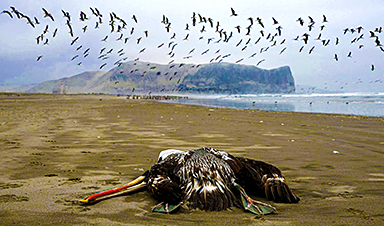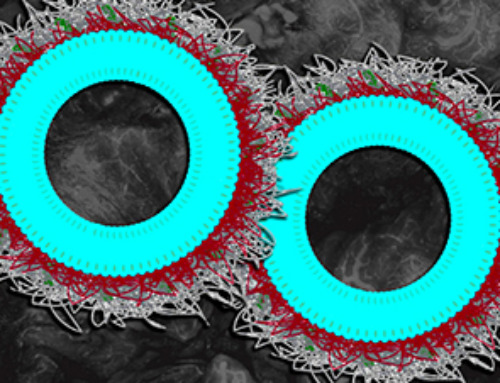A study from the University of California, Davis, and the National Institute of Agricultural Technology (INTA) in Argentina reveals that the highly contagious H5N1 avian influenza virus has evolved to transmit among birds and marine mammals, presenting a direct risk to wildlife conservation efforts.
The study, published in the journal Emerging Infectious Diseases, is the first genomic characterization of H5N1 in marine wildlife on the Atlantic shore of South America.
For the study, scientists collected brain samples from four sea lions, one fur seal, and a tern found dead at the most affected sea lion rookery in Argentina. All tested positive for H5N1.
Genome sequencing revealed that the virus was nearly identical in each of the samples. The samples shared the same mammal adaptation mutations that were previously detected in a few sea lions in Peru and Chile, and in a human case in Chile. Of note, the scientists found all these mutations also in the tern, the first such finding.
Elephant seals lie dead on a beach in Argentina following an outbreak of avian influenza in the region in 2023. Credit: Maxi Jonas
"This confirms that while the virus may have adapted to marine mammals, it still has the ability to infect birds," said first author Agustina Rimondi, a virologist from INTA. "It is a multi-species outbreak."
We know this because the virus sequence in the tern retained all mammal-adaptation mutations. Such mutations suggest a potential for transmission between marine mammals.
"This virus is still a relatively low risk for humans," said senior author Marcela Uhart, a wildlife veterinarian with the UC Davis School of Veterinary Medicine's One Health Institute and director of its Latin America Program within the Karen C. Drayer Wildlife Health Institute. "As long as the virus continues to replicate in mammals, it may make it a higher concern for humans. That's why it's so important to conduct surveillance and provide early warning."
The journey of H5N1
Uhart calls clade 2.3.4.4b — the current variant of H5N1 – "this new monster." It emerged in 2020, while the human world was reeling from a different pandemic, COVID-19. Avian influenza began killing tens of thousands of sea birds in Europe before moving to South Africa. In 2022, it entered the U.S. and Canada, threatening poultry and wild birds. It migrated to Peru and Chile in late 2022.
Then, almost exactly a year ago, in February 2023, highly pathogenic avian influenza entered Argentina for the first time. But it was not until August 2023 — when the virus was first found in sea lions at the tip of South America on the Atlantic coastline of Tierra del Fuego — that the virus unleashed its fatal potential in the region. From there, it moved swiftly northward, with deadly results, first for marine mammals and later for seabirds.
A recent paper Uhart co-authored showed a large outbreak killed 70% of elephant seal pups born in the 2023 breeding season. Mortality rates reached at least 96% by early November 2023 in the surveyed areas of Península Valdés in Argentina.
"When it first came to Argentina, we didn't know if it would affect elephant seals," Uhart said. "We never imagined the magnitude of what was to come."
Since 2022, H5N1 in South America has killed at least 600,000 wild birds and 50,000 mammals, including elephant seals and sea lions in Argentina, Chile, and Peru, and thousands of albatrosses in the Malvinas/Falkland Islands.
Moving south
The virus is now heading southward from South America, and scientists are deeply concerned about its potential impact on penguins and other wildlife in Antarctica.
Uhart and Ralph Vanstreels, her colleagues at UC Davis' Latin America Program in the School of Veterinary Medicine, are conducting wildlife surveillance for H5N1 in Antarctica this month.
"We need to keep an eye on the ability of this virus to reach species that have never been exposed to an H5N1 infection before," Rimondi said. "The consequences in those species can be very severe."
The concept of One Health honors the interconnectivity among humans, domestic animals, wildlife, and the environment. Interspecies disease outbreaks are unsettling examples of such connections and require global collaboration among public, wildlife, agricultural, health, and other sectors.
"We are trying to be at the forefront of documenting, recording, and providing early warning," Uhart said. "We've been in this area for 30 years. We know these species. We work with scientists who have 30 years of data on these populations, so we can know what will be important for the future. We have to give voice to these poor creatures. Nobody's taking note of how big this is."
Reference: "Highly Pathogenic Avian Influenza A(H5N1) Viruses from Multispecies Outbreak, Argentina, August 2023" by Agustina Rimondi, Ralph E.T. Vanstreels, Valeria Olivera, Agustina Donini, Martina Miqueo Lauriente and Marcela M. Uhart, April 2024, Emerging Infectious Diseases.
DOI: 10.3201/eid3004.231725
News
Concerning New Research Reveals Colon Cancer Is Skyrocketing in Adults Under 50
Colorectal cancer is striking younger adults at alarming rates, driven by lifestyle and genetic factors. Colorectal cancer (CRC) develops when abnormal cells grow uncontrollably in the colon or rectum, forming tumors that can eventually [...]
Scientists Discover a Natural, Non-Addictive Way To Block Pain That Could Replace Opioids
Scientists have discovered that the body can naturally dull pain through its own localized “benzodiazepine-like” peptides. A groundbreaking study led by a University of Leeds scientist has unveiled new insights into how the body manages pain, [...]
GLP-1 Drugs Like Ozempic Work, but New Research Reveals a Major Catch
Three new Cochrane reviews find evidence that GLP-1 drugs lead to clinically meaningful weight loss, though industry-funded studies raise concerns. Three new reviews from Cochrane have found that GLP-1 medications can lead to significant [...]
How a Palm-Sized Laser Could Change Medicine and Manufacturing
Researchers have developed an innovative and versatile system designed for a new generation of short-pulse lasers. Lasers that produce extremely short bursts of light are known for their remarkable precision, making them indispensable tools [...]
New nanoparticles stimulate the immune system to attack ovarian tumors
Cancer immunotherapy, which uses drugs that stimulate the body’s immune cells to attack tumors, is a promising approach to treating many types of cancer. However, it doesn’t work well for some tumors, including ovarian [...]
New Drug Kills Cancer 20,000x More Effectively With No Detectable Side Effects
By restructuring a common chemotherapy drug, scientists increased its potency by 20,000 times. In a significant step forward for cancer therapy, researchers at Northwestern University have redesigned the molecular structure of a well-known chemotherapy drug, greatly [...]
Lipid nanoparticles discovered that can deliver mRNA directly into heart muscle cells
Cardiovascular disease continues to be the leading cause of death worldwide. But advances in heart-failure therapeutics have stalled, largely due to the difficulty of delivering treatments at the cellular level. Now, a UC Berkeley-led [...]
The basic mechanisms of visual attention emerged over 500 million years ago, study suggests
The brain does not need its sophisticated cortex to interpret the visual world. A new study published in PLOS Biology demonstrates that a much older structure, the superior colliculus, contains the necessary circuitry to perform the [...]
AI Is Overheating. This New Technology Could Be the Fix
Engineers have developed a passive evaporative cooling membrane that dramatically improves heat removal for electronics and data centers Engineers at the University of California San Diego have created an innovative cooling system designed to greatly enhance [...]
New nanomedicine wipes out leukemia in animal study
In a promising advance for cancer treatment, Northwestern University scientists have re-engineered the molecular structure of a common chemotherapy drug, making it dramatically more soluble and effective and less toxic. In the new study, [...]
Mystery Solved: Scientists Find Cause for Unexplained, Deadly Diseases
A study reveals that a protein called RPA is essential for maintaining chromosome stability by stimulating telomerase. New findings from the University of Wisconsin-Madison suggest that problems with a key protein that helps preserve chromosome stability [...]
Nanotech Blocks Infection and Speed Up Chronic Wound Recovery
A new nanotech-based formulation using quercetin and omega-3 fatty acids shows promise in halting bacterial biofilms and boosting skin cell repair. Scientists have developed a nanotechnology-based treatment to fight bacterial biofilms in wound infections. The [...]
Researchers propose five key questions for effective adoption of AI in clinical practice
While Artificial Intelligence (AI) can be a powerful tool that physicians can use to help diagnose their patients and has great potential to improve accuracy, efficiency and patient safety, it has its drawbacks. It [...]
Advancements and clinical translation of intelligent nanodrugs for breast cancer treatment
A comprehensive review in "Biofunct. Mater." meticulously details the most recent advancements and clinical translation of intelligent nanodrugs for breast cancer treatment. This paper presents an exhaustive overview of subtype-specific nanostrategies, the clinical benefits [...]
It’s Not “All in Your Head”: Scientists Develop Revolutionary Blood Test for Chronic Fatigue Syndrome
A 96% accurate blood test for ME/CFS could transform diagnosis and pave the way for future long COVID detection. Researchers from the University of East Anglia and Oxford Biodynamics have created a highly accurate [...]
How Far Can the Body Go? Scientists Find the Ultimate Limit of Human Endurance
Even the most elite endurance athletes can’t outrun biology. A new study finds that humans hit a metabolic ceiling at about 2.5 times their resting energy burn. When ultra-runners take on races that last [...]






















